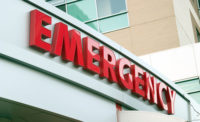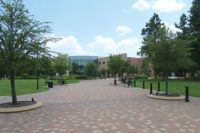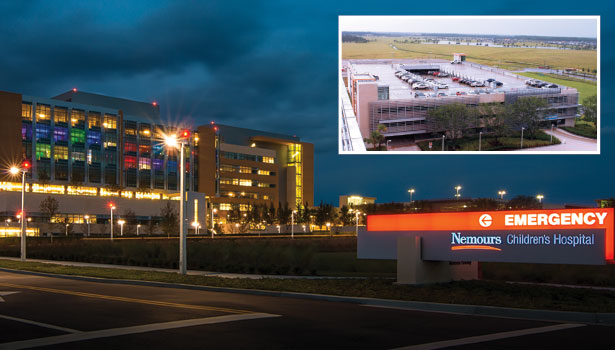Reducing Stress with Hospital Parking Security
Visiting a hospital is stressful enough; how can simplifying parking with security reduce that burden?

Security at Nemours Children’s Hospital in Orlando, Fla. works to ensure that parking remains a painless and stress-free experience, including offering free valet parking for patients and visitors. Emergency call boxes are available throughout the parking garage to immediately link visitors with security officials in the event of an emergency, or if they cannot find their car. Photos courtesy of Nemours Children’s Hospital.

“Through good planning, training and technology, security can lessen the burden on hospital visitors, patients and employees,” says Joe Summanen, Physical Security Specialist for Nemours Children’s Hospital. Photo courtesy of Nemours Children’s Hospital.

Within the four-hospital Virtua system, there are more than 2,200 surveillance cameras. Virtua’s System Safety Director, Paul Sarnese, works with best-of-breed cameras, to secure parking lots. Photo courtesy of Virtua.



Visiting a hospital can be a stressful event, especially when the admitted patient is a child. At Nemours Children’s Hospital, every possible measure is taken to reduce patient and family stress before visitors even walk into the lobby – starting in the parking garage.
Nemours Children’s Hospital, in Orlando, Fla., has a four-story parking garage, with more than 900 available parking spaces. The first and second floors are reserved for patients’ families and visitors, so they can walk directly into the hospital – an added bonus for wheelchair-bound patients. The hospital also offers free valet parking, so parents or visiting family members don’t need to remember where they parked, says Joe Summanen, Physical Security Specialist for Nemours.
“It’s just one less worry,” he says. “Long-term parking costs at hospitals can be a major burden on a family, especially when they have to choose between visiting a loved one and paying the fees.”
Virtua in southern New Jersey includes four hospitals, two long-term care facilities, health and wellness centers and ambulatory facilities, and security is assigned to all locations. The campuses are very unique, and that includes parking.
“The campuses are spread out and have multiple entrances,” says Systems Safety Director Paul Sarnese. “People come in anxious, and the last thing you want is people not knowing where to go. We rely on careful scripting for our security officers, and we work to overlap customer service and security,” he says.
But scripting and valet do not a secure lot make – Summanen and Sarnese rely on a strong partnership between technology and people.
The Tech
At Virtua, the campuses’ parking situations can be quite diverse. Some lots have fencing, others have access control gates; some use tokens and others use tote notes. At one facility, the parking lot is a half-mile from the hospital, and employees use a shuttle to get to the main building. In order to maintain a high level of security at the varying locations, Sarnese looks to best practice ideas for the lots’ security.
The four hospitals’ security directors descend on one facility at a time throughout the year for an annual security assessment, Sarnese says. Completed as a team, the security directors check parking lots too, checking lighting, signage, the integrity of fencing and locks and any hiding places within the lot that are not covered by surveillance cameras.
“When we have all of these cameras outside, well over 2,200 cameras system-wide, you have to be able to really narrow your field of vision, because everything is being recorded by motion,” Sarnese says. “Some of our parking lots are surrounded by public roads, and we don’t necessarily want to record every car driving down a public road, and we don’t want it to trigger the recording in that camera.
“We needed the right technology so we could filter out certain areas. Over the last 10 years, we’ve learned what cameras to pick and how to filter out those areas we don’t need to record,” he adds.
“We also had to keep lighting in mind, and we chose the right cameras for those areas. We work with our security integrator to obtain a comparison with several cameras side by side, or they’ll allow us to deploy a camera for several weeks. We don’t sole-source cameras because one manufacturer might make a better low-light camera, and another manufacturer might make a better thermal camera, so you have to make sure that your recording platform is more of an open architecture,” Sarnese continues. Blue-light call boxes are also located throughout the lots, including next to shuttle stops.
Nemours also utilizes emergency call boxes to increase security and reduce response time throughout the hospital’s parking garage. There are multiple units located throughout the hospital campus and on numerous walkways as well, he says. When installed in a tower, they are integrated with security cameras to allow security officers to visually assess the situation, whether it’s if a visitor has lost track of his or her car or if there’s a medical emergency in the parking garage.
“If there is a medical emergency, we have security and medical personnel stationed nearby, ready to be dispatched at any time,” says Summanen.
Nemours also conducts weekly tests of door security – a “QA of the facility,” Summanen says – to check that everything is in working order. He adds that making sure all of the security continues to run smoothly is a top priority for the hospital, and that any issues are evaluated and resolved quickly.
Night, however, can present some additional challenges.
“With night-time safety and security, there is no better asset than light,” says Summanen. “It’s important to identify your stakeholders’ expectations, understand your technology and environment, and then try to exceed those expectations through ingenuity an expertise to provide the best possible solution. That’s why we took extra time to configure, test and optimize our multi-megapixel cameras to perform to the best of their capabilities.”
Another key is to make sure everything functions while staffing is at a minimum.
The People
“We want to make certain that the technology works when there’s limited personnel,” says Summanen. “We run drills and scenarios in the off-hours to ensure that we continue to provide strong security and a quick response, even when staffing is at its lowest.”
“A lot of it comes down to the experience of our security personnel,” he adds. “Quick information is key,” which is why Nemours hospital security staff evaluate all of the data from each emergency call with the relevant and corresponding surveillance footage when possible.
At Virtua, staffing levels are based on the annual assessment, and while security personnel are present and meant to be seen, it can often be other hospital employees who are present at the time of an emergency. Every employee is introduced to security during the new employee orientation, and he or she must complete an online mandatory security education program within 30 days of hire. This program teaches them about on-campus security and violence prevention, and workers within sensitive hospital departments (cash handling, behavioral health, pharmacy, etc) receive additional security training, Sarnese says.
He also worked with marketing and IT to develop the Virtua Safety Training Network Video Series, which trains employees on how to use or react to the emergency alert systems. “We’ve got these on tornado preparedness and fire safety, and one of the most successful ones was on the emergency alert system,” Sarnese says. “We can push it out to all of our employees, and they can watch it at a staff meeting, at home, or even while they’re at work. The videos are no longer than six minutes.” For example, the emergency alert video explained to employees what the technology is (blue-light phones, panic buttons) and what happens when they do push it.
In one instance, there was a medical emergency in a parking lot, and the personnel monitoring the lot from the command center deployed an officer. Another employee who happened to be nearby got onto the emergency alert system and was passing the victim’s status along to 911 responders in order to help the individual in distress, Sarnese says.
Security personnel is also trained for customer service functions such as car battery-jumping, lock-smithing and escorting patients and employees to and from their vehicles, either on foot or by vehicle. “It’s a value-added function,” Sarnese says.
These services, along with Virtua’s other security programs, are frequently reviewed and evaluated, thanks to an annual, anonymous online security survey from employees. Asking questions such as “What do you think of security?” and “What improvements do you want to see?” the survey garners at least 2,000 responses from employees.
“We can glean a lot of great information from these surveys,” Sarnese says. “It’s a double-edged sword, though – we get great feedback on our services, but we do occasionally hear of things we need to reevaluate. But that is a positive thing, as we strive to continually make our program the best it can be to serve our employees, our patients and their families.”
Sarnese also gets feedback from patients and their families through a patient satisfaction survey.
At Nemours Children’s Hospital, no formal survey is in place yet (the hospital officially opened last October), but its Family Advisory Council (which consists of local families) is often encouraged to provide recommendations regarding how security could best serve the young patients and their families.
“Visitors will often have several emotions when arriving onsite, so it’s important for us to help mitigate as many of those outlying concerns as possible, like parking, and allow them to focus on what’s important – their child,” Summanen says. Through good planning, training and technology, security can lessen the burden on hospital visitors, patients and employees.
Anticipating Incidents at Hospital Parking Garages and Lots
For years, surveillance systems have recorded thefts and other incidences, including those at hospital parking locations, for future investigation. Now, security video can be used to stop incidents as they happen. To do this, security enterprise leaders need to quit thinking of surveillance systems as simply repositories of what’s been seen and recorded and, instead, think of security cameras as sensors in a system. Today’s video systems let hospitals stop incidents before they happen by screening for abnormal behavior such as people hanging around the lot, running or meeting in groups.
To stop crime, here are some things a hospital or medical facility can do. First, document every car and driver that enters and leaves the structure. To act as a deterrent, don’t hide the security cameras; make them visible. As a result, you can dramatically reduce car theft and shrink vandalism incidents. Then, use four basic strategies when placing the cameras:
First, at each entrance and exit, have the surveillance system capture the car, the license plate and the face of the driver, going both in and out of the garage. The recorded images provide a record of who was driving the car, a great help in determining theft claims. If there was a theft, the system captures the face of the perpetrator.
Second, have cameras cover all main driveways in and out on all floors. It’s at the turn points where most accidents occur. Your system can alert you if this happens. With the recorded video, there is documentation of who was at fault.
Third, have security cameras record video on all down ramps. This is where the majority of vandalism incidents occur. Again, your system can alert you and, with a clear image of the perpetrator, law enforcement is provided a tool to convict the vandal.
Last, put security cameras on the stairwells. This is where assaults, drug-dealing and other crimes can occur. Make sure the cameras are very visible to deter people with bad intentions.
By Nathan Needel, COO, PRD International, Manufacturer of Polaroid Professional Security Solutions
Looking for a reprint of this article?
From high-res PDFs to custom plaques, order your copy today!









